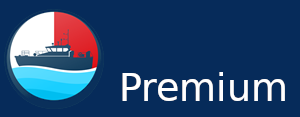Article Factors affecting maritime pilots' health and well-being: a systematic review
published on 18 June 2021
Article Standard for Health Assessment of Marine Pilots - NSW (2009)
published on 22 June 2021
Article Predicting Maritime Pilot Selection with Personality Traits
by Marine-Pilots.com - published on 7 July 2021
Article Investigation of ship maneuvering with hydrodynamic effects between ship and bank
by Marine-Pilots.com - published on 12 July 2021
Article The Risks of Remote Pilotage in an Intelligent Fairway - preliminary considerations
published on 28 July 2021
Article Maritime Pilots’ Risky Operational Behavior Analysis Based on Structural Equation Model
published on 12 October 2022
Article Study: "An evaluation of fatigue factors in maritime pilot work scheduling"
by Marine-Pilots.com - published on 17 September 2020
Article Psychophysical stress and strain of maritime pilots in Germany. A cross-sectional study
published on 12 June 2021
Article Study: "Performance assessment in full-scale simulators"
published on 14 July 2021
Article Study: Online survey among maritime pilots: job-related stress...
published on 2 September 2021
Related content
Video Maritime Pilotage, Monitoring Pilot Orders , (By ATSB)
published on 11 January 2023
Article Psychophysical stress and strain of maritime pilots in Germany. A cross-sectional study
published on 12 June 2021
Article Standard for Health Assessment of Marine Pilots - NSW (2009)
published on 22 June 2021
Video Pilot boat goes out, Pilot Boat comes in. The saltie Cape comes in. Busy Sunday in Duluth!
published on 3 May 2020
I decided to show the typical happenings when a saltwater freighter arrives Duluth. Most of the time they go to anchor and wait for the Elevator dock. The Pilot Boat brings out the Great Lakes Pilot to sail the ship into the port and to the dock. This vessel arrived early Sunday morning, went to anchor until mid afternoon. They are loading grain at the CHS Elevator in Superor.
Article Incident in Port Tampa Bay, harbor pilot guides to safety
by WFLA - published on 9 September 2024
Video As NorthQueensland (Australia) As
published on 11 July 2024
Video Maritime Pilot - The grounding of Leda Maersk - Episode 5
by Captain Ahmed Sati - published on 12 August 2024
Video Marine pilot by helicopter // A whale in rough weather // Berthing in Durban port
published on 25 October 2021
In this video we would like to share our experience while berthing in port Durban … weather was rough .. witnessed a whale enjoying in big waves .. a doctor came onboard for covid test … received pilot by helicopter and so on …
Hope you all would like the content…
Feel free to drop us a message
tdandu03@gmail.com
Video Pilots Take on Rough Seas
published on 24 March 2022
Video Pilot Boat MV Paga Launched at PNG Ports
published on 4 November 2022
Papua New Guinea Ports Corporation in partnership with the Australian Government had christened a K5million new customized Pilot boat called MV Paga on Tuesday November 1st. The launching of another Pilot boat was stated as the culmination of the hard work put together by the Australian High Commission, the Australian Infrastructure Financing Facility for the Pacific, and PNG Ports Corporation. #pngnews #looppng #tvwannews #digiceltv #digicel #bettertogether LATEST NEWS: http://www.looppng....


